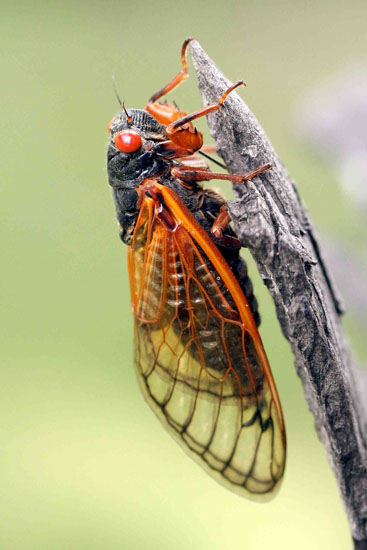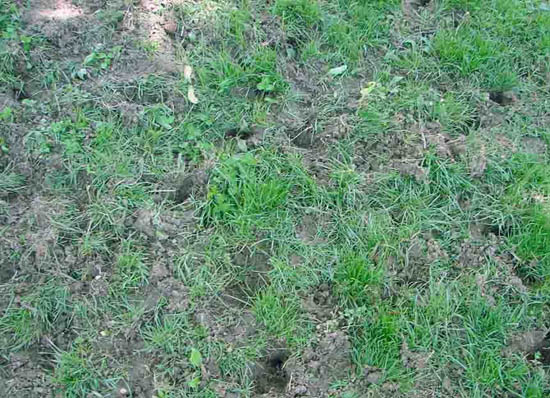Issue 2, May 2, 2011
Periodical Cicada
Periodical cicadas are scheduled to emerge this year in most of the southern half of Illinois as part of the Great Southern Brood, Marlatt's XIX brood. Emergence is expected in mid to late May when the males will sing for two to three weeks, followed by about a month of female egg-laying.

As can be seen on the emergence map, the northern edges of emergence will be Hancock and McDonough counties on the west and Iroquois, Ford, and the southeastern corner of Livingston counties on the east. Between those two areas, the northern edge of Sangamon County is level with the northern edge of the emergence across the center of the state. In southern Illinois, Pulaski, Alexander, Union, Jackson, and the southern parts of Perry and Randolph counties are not part of this brood. The easternmost row of counties south to Wabash County also is not part of this brood. Vermilion, Edgar, Clark, and Crawford counties are part of the Great Eastern Brood that will emerge in 2021. Lawrence, Wabash, Pulaski, Alexander, Union, and Jackson counties are in the Lower Mississippi River Valley Brood which will emerge in 2015.

Periodical cicada nymphs feed on the roots of trees and shrubs for 13 years in the southern half and 17 years in the northern half of the U.S. Illinois has both lengths of broods; this is a 13 year brood that emerged previously in 1998. In the spring of the 13th year, this year, the cicada nymphs migrate upward through the soil and wait just under the soil surface for a few weeks. They frequently build chimneys of soil above the soil surface that are finger to thumb-sized and about one inch high while waiting to emerge. This upward movement through the soil is already occurring as seen in the photo of what appears to be damage from skunks feeding on the ascended cicada nymphs. This photo and the nymph photo were submitted by Mike Roegge, Extension Educator for Adams and Brown counties.


The nymphs are expected to emerge from the soil in the second half of May, climb up any vertical object, including trees, shrubs, and buildings, and emerge as adults. The nymphal skin splits down the back and the whitish adults pull themselves out, leaving the nymphal shell (exoskeleton) attached to trunks, leaves, and siding. Over the next few hours, the adult's exoskeleton will harden and the color will change to a black body with red eyes and orange veins on transparent wings. Adult periodical cicadas are about one and one-quarter inches long, much smaller than the dogday or annual cicadas that emerge later in the summer.
Unlike the dogday cicadas which sing in the evening, periodical cicada males sing during the day to attract females to them for mating. This male singing blends into a high-pitched trill when many are singing together. They sing and mate for two to three weeks and the males die. Then the females concentrate on egg-laying for about the next month.
Although both male and female cicadas use their piercing-sucking mouthparts to feed on xylem fluids, they do not feed very much and do not cause significant damage. It is the female egg-laying that is most damaging. Females use their ovipositors to slice twigs, branches, and trunks up to two inches in diameter to lay their eggs. These longitudinal slits are usually two or more inches long and about one-eighth inch deep. They insert their eggs vertically into the slits.
These egg-laying slits interrupt the flow of water and nutrients, causing the leaves to wilt and turn brown. The slits also weaken twigs and branches, and many snap during windy conditions. A heavily attacked tree or shrub in late summer typically has many patches of brown leaves and the ground becomes littered with fallen twigs and branches. On established trees and shrubs, this functions as pruning, resulting in no serious damage to the plant. Trees and shrubs will appear bushier for a couple of years due to the lateral bud break resulting from this pruning. Twigs and branches that do not snap will have callous tissue associated with the egg-laying slits that is obvious for a couple of years. Young trees with trunks up to two inches in diameter are likely to snap off from these ovipositional slits.
In the late summer into early fall, the cicada eggs will hatch into first stage nymphs. These nymphs free fall from the twigs to the soil, then burrow through the soil, find a root and start sucking sap. Through their underground life, nymphs will switch roots occasionally but rely on live roots to survive. Where large numbers are present, tree growth is reduced by this feeding in the last few years before emergence. This can be detected in narrower annual rings in the trunks, allowing these insects to be traced for hundreds of years in large, old trees and even fossil trees.
Periodical cicadas typically fly only one-half mile or so when they emerge. With a generation only every thirteen years, these insects do not spread very far during human lifetimes. They will not be present in areas where all of the trees and shrubs have been killed as in housing developments during the last 30-40 years. Before that, housing sites were not totally cleared, allowing the cicada nymphs to survive. Similarly, in areas of the state that were predominately prairie, frequent prairie fires eliminated their trees and them before settlement times. There have not been enough generations since that time for them to move back. In prairie areas, periodical cicadas are found primarily on the east sides of north-south flowing rivers which acted as firebreaks for prairie fires blown by predominately westerly winds.
Insecticidal control of periodical cicadas is usually not practical. Carbaryl (Sevin), pyrethroid and other insecticides kill huge numbers of cicadas, but past research studies have shown very little reduction in egg-laying damage. However, very young trees in nurseries can be protected with multiple insecticide applications. Individual young trees can be protected with wire screening around the trunk. Make sure that there is no entrance at top and bottom, particularly the bottom as cicadas tend to crawl upwards. The screening should not be tight against the trunk to prevent cicadas from laying eggs into the trunk through the screening. Plastic tree wraps without holes also are effective. Realize that you have about two weeks to install the protection after the singing starts. This will help you determine where and if you need apply it. (Phil Nixon)
Author:
Phil Nixon